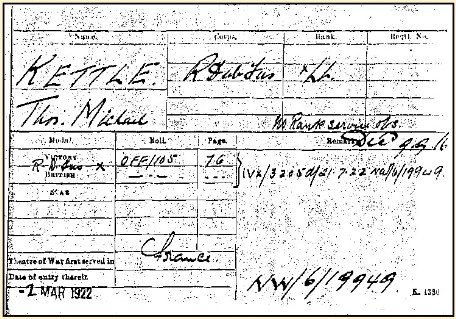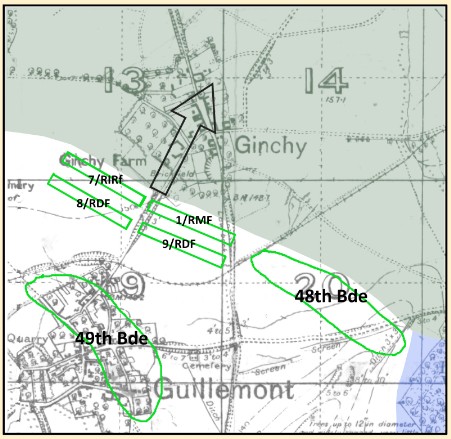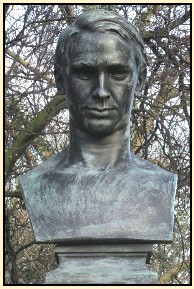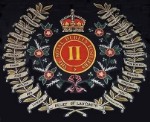Tom Kettle
"From a strongly political, middle-class Catholic family, by his 30s he was a barrister, Professor of National Economics, and had previously been an MP for the Irish Parliamentary Party." James Joyce and Tom Kettle met at the Catholic University, Dublin (which later became University College Dublin), Kettle having matriculated in 1897; Joyce in 1898. Joyce, for twenty years, regarded Kettle as his best friend in Ireland and while in Zurich wrote of him to his widow as an "old school fellow of benevolent and courteous friendship." Kettle, like Joyce, was born in a Dublin suburb and except for his years at Clongowes Wood College, was a lifelong Dubliner.
n/ BBC One, "Tom Kettle," Voices 16; Letter to Mrs. Thomas Kettle, September 25, 1916, Stuart Gilbert, ed., Letters of James Joyce, Vol. 1 (New York: Viking, 1966), 96.

Home of Tom and Mary Kettle
23 Northumberland Road, Pembroke, Dublin

© 2022 Google
Kettle's Pembroke house, like 7 Eccles Street, has a ground level, basement, and two upper levels. The census enumerators classified it a 2nd Class Building based on its construction, number of rooms, and number of windows facing the street. As it was occupied by only one household, the Kettle's had "2nd Class Accommodation" which compared to that of most Dubliners, was luxurious.
Timeline, Life of Tom Kettle

"Kettle, Thomas Michael," Dictionary of Irish Biography
The online DIB, a project of the Royal Irish Academy, has a comprehensive biography of Tom Kettle contributed by Donal Lowry, last revised October 2009. Click on the icon to the right and the DIB webpage for Kettle will open in a new browser window.
Tom's Brother Laurence
Laurence J. Kettle's career took a scientific path; he studied electrical engineering at Faraday House, London. Of interest to Joyceans is that while employed by the Dublin Electricity Board, Laurence's office was in the Pigeon House generating station mentioned in "Proteus." Click on the icon to the right and the DIB webpage for Laurence Kettle will open in a new browser window.
n/ Letters of Laurence Kettle to War Office, Service Record of Lt. Thomas M. Kettle. UK National Archives WO 339/13445.
James Joyce and Tom Kettle
Both James Joyce and Tom Kettle were born into prosperous, Catholic families though Joyce's father would gradually squander the family fortune. By the time James was at Catholic University Dublin, his family lived in genteel poverty like the Dedalus family of Ulysses. Joyce and Kettle may have first encountered each other at the Christian Brothers primary school on North Richmond Street (O'Connell School). Joyce attended there briefly. Kettle received his secondary schooling at Clongowes Wood College, 1894-1897, which Joyce had attended earlier in the primary schooling division.
n/ Terrence Killeen, "The best friend I have in Ireland, I think," Irish Times, September 26, 1016; Richard Ellmann, James Joyce, Rev. Ed. (New York: Oxford Univ. Press, 1982), 27-35.
At university, Joyce and Kettle were members of the Literary and Historical Society and through their shared interest in literature, history, and Irish nationalism, became friends. They were together at Catholic University from 1898, when Joyce entered, and 1900, when Kettle left. Both contributed papers to the school's journal of Irish social life, St. Stephen's, of which Kettle became editor. They also were members of the Choral Union, which naturally attracted Joyce, an accomplished vocalist. Kettle and Joyce were part of a clique that included Joyce's friends Constantine Curran, Francis Skeffington, and Eugene Sheehy, brother of the Sheehy Sisters. Skeffington would marry Hannah Sheehy in 1903; Kettle would marry Mary Sheehy in 1909. Joyce, during his last year in secondary school, befriended the nearby Sheehy family. He developed a crush on the very pretty Mary that endured for several years. (For a photograph, click on her link for an image on the Irish Times' website. It will open in a popup window. Also, see photograph below of the Sheehy Sisters. Click on that link to jump to that block.)
n/ Fathers of the Society of Jesus, A Page of Irish History: Story of University College, Dublin (Dublin: Talbot, 1930); Ellmann, James Joyce, 51-52.
After Joyce left Ireland in 1904, he and Kettle corresponded regularly, especially about Joyce's works: Chamber Music, Dubliners, and A Portrait of the Artist as a Young Man. During Joyce's 1909 stay in Dublin, he met with Kettle several times and according to Joyce, Kettle promised to help get Dubliners published.
The Falling Out Over Dubliners:
Though Joyce completed Dubliners in 1906, in 1912 he still lacked a publication commitment as his Dublin publisher, George Roberts, had qualms over legal liabilities the book would entail. That summer, Joyce went to Dublin to spur his publisher to bring out the book. He first consulted Kettle about the likelihood that lawsuits would arise from publication. Kettle agreed with Roberts that the book's mention of personal names and premises was indeed libelous, and the publisher and author would be held accountable in court. Kettle also expressed his dislike for the stories, particularly, "An Encounter." According to Ellmann, Kettle said Dubliners was "beyond anything in its outspokenness he had ever read" while admitting of the pedophile in "An Encounter," that "we have all met him." Overall, Kettle thought the book would harm Ireland. Joyce held Kettle responsible for the failure of Dubliners to be published that year. He wrote to T. S. Eliot: "Dubliners was banned there in 1912 on the advice of a person who was assuring me at the time of his great friendship." That person was Kettle, who purportedly told Joyce should Dubliners be published, he would use his considerable influence as a critic to ensure its financial failure ("I'll slate that book").
n/ Ellmann, James Joyce, 63, 329, 338; Letter to T.S. Eliot, January 1, 1932. Richard Ellmann, ed., Selected Letters of James Joyce (New York: Viking, 1966), 359.
Click on the above link and Kettle's review of Joyce's book of poetry for the Freeman's Journal , will open in a popup window. The review is in a pdf on this website.
Kettle in Joyce's Correspondence
Condolence letter to Mrs. Thomas Kettle, September 26, 1916. Letters I, 96, Includes the story of the murder of Francis Skeffington by a British Army officer, referenced by Joyce in the letter. Click on the link and the letter, in a pdf on this website, will appear in a popup window.
October 3, 1905: Postcard to his brother Stanislaus; asks him to retrieve the Stephen Hero manuscript from Kettle. Letters II, 114. [Joyce would later refashion this work into the autobiographical A Portrait of the Artist as a Young Man.]
October 15, 1905: Postcard to Stanislaus; asks him to see Kettle about publishing Joyce's poems in the Nationalist, of which Kettle was editor. Letters II, 122.
August 16, 1906: Letter to Stanislaus; comments on Kettle's election to Parliament as follows: "How the devil did you think the news about Kettle would interest me." SL, 97.
August 31, 1906: Letter to Stanislaus; mentions he saw an advertisement for "some booklet by (very big letters) Thomas Kettle, M.P." Letters II, 153.
September 6, 1906: Letter to Stanislaus; states he has no interest in Kettle's parliamentary work and comments on his friendship with Kettle. Letters II, 157.
August 21, 1909: Letter to Stanislaus; mentions that "Kettle was most friendly to me." [Supportive of Joyce's attempt to obtain a teaching position in Italy.] SL, 102.
September 2, 1909: Letter to Stanislaus; tells him he didn't give the Portrait manuscript to Kettle as he's going to be married next week. Letters II, 244.
September 5, 1909: Letter to Nora Barnacle; writes of Kettle: "He is the best friend I have in Ireland, I think, and he has done me great services here." Plans to send Kettle a copy of his published poem collection, Chamber Music. Letters II, 248.
September 9, 1909: Letter to Stanislaus; tells him to have Nora prepare for a visit in Trieste by the honeymooning Kettles. Letters II, 252. [They never did make it to Trieste.]
November 17, 1909: Letter to Stanislaus; informs him their brother Charlie is unemployed and destitute, but Joyce won't ask Kettle to help him. Letters II, 262.
January 3, 1911: Letter to George Roberts; thanks him for the copy of Kettle's book [Home Rule Finance]. Letters II, 287.
January 8, 1927: Letter to Stanislaus; asks for "Kettle's two books" [probably, The Day's Burden (1910) and Home Rule Finance (1911)]. Letters III, 149.
Abbreviations:Letters I - Stuart Gilbert, ed., Letters of James Joyce, Vol. 1 (New York: Viking, 1966).Letters II - Richard Ellmann, ed., Letters of James Joyce, Vol. 2 (New York: Viking, 1966).Letters III - Richard Ellmann, ed., Letters of James Joyce, Vol. 3 (New York: Viking, 1966).SL - Richard Ellmann, ed., Selected Letters of James Joyce (New York: Viking, 1975).
First World War Military Service
Archival Note, Officer Service Record, Thomas Michael Kettle

UK National Archives, WO 339/13445 © Crown Copyright
At the outbreak of war in August 1914, Kettle was in Belgium to purchase arms for the Irish Volunteers. He was a founder of that illegal, nationalist militia formed to counter the Ulster Volunteers, the illegal, unionist militia. While Dublin Castle did not interfere with the Ulster Volunteers, it did make sure the Royal Irish Constabulary and the Coast Guard inhibited the arming of the Irish Volunteers. His "cover" for being in Belgium was war correspondent for London's Daily News. He returned to Ireland in September 1914 and sought a wartime commission with the Royal Dublin Fusiliers.
During the war, three Irish infantry divisions were formed: 16th and 36th (Ulster) which were employed on the Western Front; 10th in the Eastern Mediterranean (Gallipoli, Salonika, Egypt, Palestine). In the Spring of 1918, nearly all Irish battalions of the 10th Division were sent to France as reinforcements. Those battalions were replaced by British and Indian units and the 10th was no longer an Irish division.
James Joyce was interested in the Irish contribution to the Entente's war effort. In Zurich, he purchased S. Parnell Kerr's What the Irish Regiment's Have Done, a 1916 account of the Irish in the British Army during the First World War. The preface is by John Redmond, leader of the Irish Parliamentary Party and Kettle's colleague.
n/ Denis Gwynn, "Thomas M. Kettle 1880-1916," Studies: An Irish Quarterly Review 55, no. 220 (Winter 1966): 384-91; Chris Baker, "10th (Irish) Division," The Long, Long Trail, www.longlongrail.co.uk.
Medal Card, Thomas Michael Kettle

UK National Archives WO 372/11/150278 © Crown Copyright.
Home Service
In December 1915, at age 34, Kettle entered the officer training program for the new 16th (Irish) Division with the rank of first-lieutenant. Such training was conducted by Company C of 7th Battalion, The Leinster Regiment. Kettle completed the course in March 1915, but the War Office didn't place him with any of the 16th Division's battalions. Because of his prominence, poor health (due to alcoholism), and age, the government reassigned Kettle from the infantry to the War Office's propaganda effort. He remained; however, on the Leinster's officer list. In May, likely at Kettle's request, the War Office transferred his temporary commission to the Royal Dublin Fusiliers and placed him on its 9th Battalion's officer list. He never trained with his battalion as the War Office kept him as a propagandist. During the war, about 400 students and graduates of UCD, Kettle's university, served with the Royal Dublin Fusiliers. About 80% of the 9th Battalion's men were from Dublin. For another cultured, UCD graduate who though an ardent nationalist, was commissioned into the 9th Battalion, see Bernard Reid, near the bottom of this page. (Click on the link to jump to that block.)
As a uniformed proponent of the UK's participation in the First World War, Lt. Kettle made 182 recruiting speeches, wrote a collection of recruiting ballads, and authored many pro-war articles for the Irish and British press. For this work, many of his nationalist colleagues branded him a traitor, and after the 16th Division went to France, accused him of cowardice.
Kettle was unhappy with his propaganda work as he joined-up to fight the Germans. He repeatedly asked his superiors to send him to his infantry unit, but with no success. Finally, in the Spring of 1916, the War Office relented and authorized him to join the 9/Royal Dublin Fusiliers, then in France.
n/ Tom Burke, "In Memory of Tom Kettle," essay presented at the symposium on the Irish regiments by Dublin City Library, Dublin City Archives, and The Royal Dublin Fusiliers Association, September 9, 2017; London Gazette - Supp. February 1, 1915, May 4, 1915; Monthly Army List, various editions.
On the Western Front
The 16th Division arrived in France in December 1915. Among its components was 9/Royal Dublin Fusiliers, Lt. Kettle's battalion. On July 19, when Lt. Kettle joined his battalion, it was part of the 47th Brigade along with 8/Royal Dublin Fusiliers, 1/Royal Munster Fusiliers (a regular army formation), and 7/Royal Irish Rifles. The 9th was one of the battalions then in the front-line trenches.
Kettle arrived shortly before the start of Phase 2 of the Anglo-French Somme Offensive, a bloody and ultimately pointless, multi-month campaign. Click on the link and a campaign map will open in a popup window. It's in a jpg file on this website.
9/RDF History, July 19 - September 9, 1916
In Front-Line | Activity | Casualties |
| July 19 - 23 | Reconnaisance patrols. Received artillery fire. | |
| July 28 - August 8 | Raid on German trenches. Received artillery fire. | July 19-31: 7 Dead, 20 Wounded |
| August 12 - 16 | Reconnaisance patrols. Received artillery fire. | |
| August 20 - 24 | Reconnaisance patrols. Received artillery fire. | August 1-31: 11 Dead, 44 Wounded |
| September 4 - 9 | Received artillery fire. Attack on German-held Ginchy. | September 1-8: 1 Dead, 7 Wounded |
On September 3, 1916 the British launched a major attack on the German lines as Phase 2 of the Somme Offensive. The 16th Division's objective was the German-held village of Ginchy and launched its attack with the 47th Brigade on the left and the 48th Brigade on the right. The 49th Brigade was held in reserve. The 48th Brigade attacked northeast and in two days had taken the German-held village of Guillemont, about 1.5 kilometers south of Ginchy. On September 6, it moved onward and the 47th Brigade took up position just north of the recently captured village. On September 9, the 47th Brigade attacked. 9/Royal Dublin Fusiliers reached its first and then second objective but had to pull back due to heavy casualties. The 16th Division took Ginchy but could advance no farther. The division incurred 4,330 casualties (killed, wounded, or captured), well over half the men of the two brigades employed.
Note: At the time of the battle, civilians had long been evacuated from the two villages which were in ruins from shelling.
16th (Irish) Division's Attack on Ginchy

For the 9th Battalion, the battle began inauspiciously as on September 6, its commander and second-in-command were wounded by artillery fire and both sent to hospital the following day. The battalion's adjutant, Captain W. J. Murphy, took temporary command. The British artillery bombardment to support the 47th Brigade began at noon on September 9, and the gunners accidentally shelled 7/Royal Irish Rifles. The uninjured survivors of the friendly fire numbered only 150 and the battalion, effectively at company strength, was replaced with 7/Royal Irish Fusiliers of the reserve brigade. During the late afternoon, the 9th Battalion went "over-the-top" and within minutes, Lt. Kettle, commanding Company B, was killed by enemy machine-gun fire. Tom Kettle died the day after his seventh marriage anniverseray; his remains were never recovered. Before nightfall, 16 of the battalion's 18 combatant officers were casualties; only two second-lieutenants were unscathed.
On September 10, GHQ removed the 16th Division from the line. The 8th and 9th Battalions of the Royal Dublin Fusiliers were decimated and the following month, the War Office merged them and designated the resulting unit 8/9 Battalion.
n/ Monthly Army List, June 1915; Tom Burke, "In Memory of Lieutenant Tom Kettle," Dublin Historical Record 57, no.2 (Autumn 2004): 164-73; War Diary of 9/Royal Dublin Fusiliers, UK National Archives WO 95/1977.9/Royal Dublin Fusilier officer casualties in the Ginchy attack were 5 killed, 10 wounded, and 1 taken prisoner. Among the dead was Cpt. Murphy, acting commanding officer. Note that at the commencement of the attack, the 9th Battalion had only 18 of its authorized 27 combatant officers.One of the wounded was Lt. James Dalton who received the Military Cross for "great bravery and leadership in action" at Ginchy. Dalton and Kettle had known each other before the war and when Kettle arrived in France, they became friends. In post-war Ireland, Dalton befriended the IRA leader, Michael Collins, and in 1922 became a general in the Irish Free State's army. During the Irish Civil War, he commanded state troops that took Cork through an amphibious operation. In 1925, the government forced Dalton to resign his commission on account of his alcoholism. During the Second World War, Dalton worked in London's film industry. In the 1950s, he returned to Ireland where he became a prominent film producer. Dictionary of Irish Biography, s.v. "Dalton, (James) Emmet."
Lengthy article on Kettle's desire for combat service and the letters he wrote home while on the Western Front. On RTE's Century Ireland website, a joint effort by RTE (the Irish state broadcasting company) and Boston College. Click on the link above for the article; on the icon on the right for the home page of Century Ireland. Webpages will open in new browser windows.
Poem to My Daughter Betty
"In the field, before Guillemont, Somme, Sept. 4, 1916."
In wiser days, my darling rosebud, blown
To beauty proud as was your mother's prime,
In that desired, delayed, incredible time,
You'll ask why I abandoned you, my own,
And the dear heart that was your baby throne,
To dice with death. And oh! they'll give you rhyme
And reason: some will call the thing sublime,
And some decry it in a knowing tone.
To beauty proud as was your mother's prime,
In that desired, delayed, incredible time,
You'll ask why I abandoned you, my own,
And the dear heart that was your baby throne,
To dice with death. And oh! they'll give you rhyme
And reason: some will call the thing sublime,
And some decry it in a knowing tone.
So here, while the mad guns curse overhead,
And tired men sigh with mud for couch and floor,
Know that we fools, now with the foolish dead,
Died not for flag, nor King, nor Emperor,—
But for a dream, born in a herdsman's shed,
Know that we fools, now with the foolish dead,
Died not for flag, nor King, nor Emperor,—
But for a dream, born in a herdsman's shed,
And for the secret Scripture of the poor.

Bust in Stephen's Green
Kettle's Books on the Worldwide Web
Available on other websites. Note: The webpages will open in new browser windows.
* Indicates a copy was owned by James Joyce.
Dublin: Maunsel & Company, 1911. On the website of the Hathi Trust. Requires partner login to download the entire book.
Dublin: Talbot Press, [1916?]. Downloadable from the Hathi Trust.
New York: Charles Scribner's Sons, 1917. Includes a memoir by his wife, Mary Sheehy Kettle. Downloadable from the Internet Archive.
Dublin: Maunsel and Company, 1918. Downloadable from the Internet Archive.
London: W.J. Ham-Smith, 1912. Introduction by John Redmond. Downloadable from Project Gutenberg.
Dublin: Talbot Press, 1916. Downloadable from Project Gutenberg.
Links to Other Websites
Note: The webpages will open in new windows.
Click on the link to go to that page of the website. Click on the icon to go to the website's home page.
The University College Dublin Library's online exhibition archived by Google Arts. Tom Kettle is featured in the first part of this exhibition on Ireland and the First World War.
Page from a BBC online exhibition that presents the year 1916 through the lives of thirty-one people. Most stories involve the First World War or the Easter Rising. Extensive material on Kettle that includes his education, political and academic careers, marriage, and involvement with the Irish Volunteers.
This officer of 9/Royal Dublin Fusiliers, like Kettle, joined the British Army not to fight for Empire but for a small, cultured, Catholic country: Belgium. Reid, a UCD graduate from Dalkey, Co. Dublin, was friend of the writers Hilaire Belloc and George Moore. Link is to a page on the website of Fin Keegan, author of Grace and the Fusilier and a short biography of James Joyce. Click here for a photograph of Lt. Reid on the Facebook page of the National Museum of Ireland.
Hannah - Mary - Kathleen - Margaret
Tom Kettle's wife, Mary, was one of four daughters of David Sheehy and Bessie McCoy. Sheehy, born in Limerick, was active with the Land League and for several years was a nationalist MP. In 1887, the Sheehy family moved to Drumcondra, then a Dublin suburban township. Click on the link and a 1905 photograph of the four sisters will open in a popup window. The image is on Edwardian Ladies and beyond, a pinterest.ie board of "the Giggly Teapot."
The Sheehy Sisters are from left to right: Hannah (who would marry Joyce's friend Francis Skeffington), Mary (Kettle's future wife), Kathleen (who would marry Frank Cruise O'Brien of the Freeman’' Journal;) Margaret (who with her second husband, Michael T. Casey, emigrated to Montreal in 1922).
Joyce maintained an interest in the Sheehy family. When he visited Dublin in 1909, he wrote to his brother Stanislaus in Trieste: "Kettle marries Mary Sheehy on the 8 Sept. Kathleen marries Cruise O'Brien. Skeffington has a son two months old." Letter to Stanislaus, August 21, 1909, Letters II, 238.
Photographs of Tom Kettle
Images will open in popup windows.
Paper by Conor Mulvagh on a letter in the UCD Archives from Redmond to his trusted agent, Kettle, who at the time was travelling between England and Belgium to procure arms for the Irish Volunteers. The paper is in a pdf on the website History Hub maintained by the School of History, UCD.
Terence Killen, "The afflicted mother - two letters," James Joyce Online Notes 7 (September 2014). A brief article about two letters sent over the New Year period of 1903-04 by the mother of Oliver St. John Gogarty to Tom Kettle. In them, she seeks Kettle's help in straightening out the errant Gogarty (the Buck Mulligan of Ulysses).
Catalog of Kettle's papers deposited in the UCD Archives by Conor Cruise O'Brien in 1987. His mother was Kathleen Sheehy, Kettle's sister-in-law. This 69-page item is in a pdf on the UCD website. The Kettle Papers are cataloged IE UCD LA34.
Image of the handwritten census return of the Kettle household: Tom, his wife Mary, and Mary Redmond, the live-in domestic. At the time, the Kettles resided at 23 Northumberland Road, Pembroke. Note the changes made by Kettle on the signature line in the lower-right.







